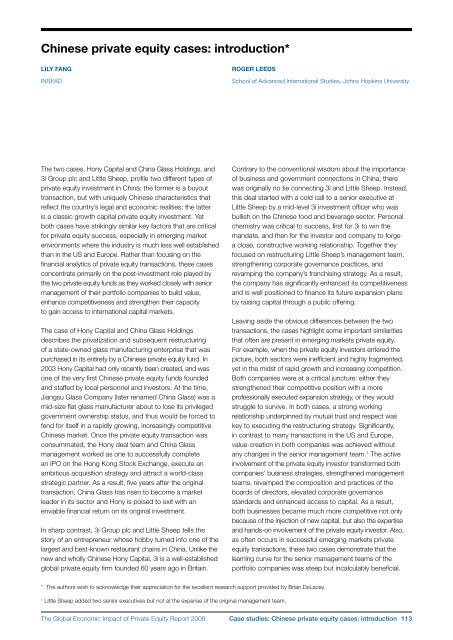The Global Economic Impact of Private Equity Report 2008 - World ...
The Global Economic Impact of Private Equity Report 2008 - World ...
The Global Economic Impact of Private Equity Report 2008 - World ...
- No tags were found...
Create successful ePaper yourself
Turn your PDF publications into a flip-book with our unique Google optimized e-Paper software.
Chinese private equity cases: introduction*lily FanginseadRoger LeedsSchool <strong>of</strong> Advanced International Studies, Johns Hopkins University<strong>The</strong> two cases, Hony Capital and China Glass Holdings, and3i Group plc and Little Sheep, pr<strong>of</strong>ile two different types <strong>of</strong>private equity investment in China: the former is a buyouttransaction, but with uniquely Chinese characteristics thatreflect the country’s legal and economic realities; the latteris a classic growth capital private equity investment. Yetboth cases have strikingly similar key factors that are criticalfor private equity success, especially in emerging marketenvironments where the industry is much less well establishedthan in the US and Europe. Rather than focusing on thefinancial analytics <strong>of</strong> private equity transactions, these casesconcentrate primarily on the post‐investment role played bythe two private equity funds as they worked closely with seniormanagement <strong>of</strong> their portfolio companies to build value,enhance competitiveness and strengthen their capacityto gain access to international capital markets.<strong>The</strong> case <strong>of</strong> Hony Capital and China Glass Holdingsdescribes the privatization and subsequent restructuring<strong>of</strong> a state‐owned glass manufacturing enterprise that waspurchased in its entirety by a Chinese private equity fund. In2003 Hony Capital had only recently been created, and wasone <strong>of</strong> the very first Chinese private equity funds foundedand staffed by local personnel and investors. At the time,Jiangsu Glass Company (later renamed China Glass) was amid‐size flat glass manufacturer about to lose its privilegedgovernment ownership status, and thus would be forced t<strong>of</strong>end for itself in a rapidly growing, increasingly competitiveChinese market. Once the private equity transaction wasconsummated, the Hony deal team and China Glassmanagement worked as one to successfully completean IPO on the Hong Kong Stock Exchange, execute anambitious acquisition strategy and attract a world-classstrategic partner. As a result, five years after the originaltransaction, China Glass has risen to become a marketleader in its sector and Hony is poised to exit with anenviable financial return on its original investment.In sharp contrast, 3i Group plc and Little Sheep tells thestory <strong>of</strong> an entrepreneur whose hobby turned into one <strong>of</strong> thelargest and best-known restaurant chains in China. Unlike thenew and wholly Chinese Hony Capital, 3i is a well-establishedglobal private equity firm founded 60 years ago in Britain.Contrary to the conventional wisdom about the importance<strong>of</strong> business and government connections in China, therewas originally no tie connecting 3i and Little Sheep. Instead,this deal started with a cold call to a senior executive atLittle Sheep by a mid-level 3i investment <strong>of</strong>ficer who wasbullish on the Chinese food and beverage sector. Personalchemistry was critical to success, first for 3i to win themandate, and then for the investor and company to forgea close, constructive working relationship. Together theyfocused on restructuring Little Sheep’s management team,strengthening corporate governance practices, andrevamping the company’s franchising strategy. As a result,the company has significantly enhanced its competitivenessand is well positioned to finance its future expansion plansby raising capital through a public <strong>of</strong>fering.Leaving aside the obvious differences between the twotransactions, the cases highlight some important similaritiesthat <strong>of</strong>ten are present in emerging markets private equity.For example, when the private equity investors entered thepicture, both sectors were inefficient and highly fragmented,yet in the midst <strong>of</strong> rapid growth and increasing competition.Both companies were at a critical juncture: either theystrengthened their competitive position with a morepr<strong>of</strong>essionally executed expansion strategy, or they wouldstruggle to survive. In both cases, a strong workingrelationship underpinned by mutual trust and respect waskey to executing the restructuring strategy. Significantly,in contrast to many transactions in the US and Europe,value-creation in both companies was achieved withoutany changes in the senior management team. 1 <strong>The</strong> activeinvolvement <strong>of</strong> the private equity investor transformed bothcompanies’ business strategies, strengthened managementteams, revamped the composition and practices <strong>of</strong> theboards <strong>of</strong> directors, elevated corporate governancestandards and enhanced access to capital. As a result,both businesses became much more competitive not onlybecause <strong>of</strong> the injection <strong>of</strong> new capital, but also the expertiseand hands‐on involvement <strong>of</strong> the private equity investor. Also,as <strong>of</strong>ten occurs in successful emerging markets privateequity transactions, these two cases demonstrate that thelearning curve for the senior management teams <strong>of</strong> theportfolio companies was steep but incalculably beneficial.* <strong>The</strong> authors wish to acknowledge their appreciation for the excellent research support provided by Brian DeLacey.1Little Sheep added two senior executives but not at the expense <strong>of</strong> the original management team.<strong>The</strong> <strong>Global</strong> <strong>Economic</strong> <strong>Impact</strong> <strong>of</strong> <strong>Private</strong> <strong>Equity</strong> <strong>Report</strong> <strong>2008</strong> Case studies: Chinese private equity cases: introduction 113















